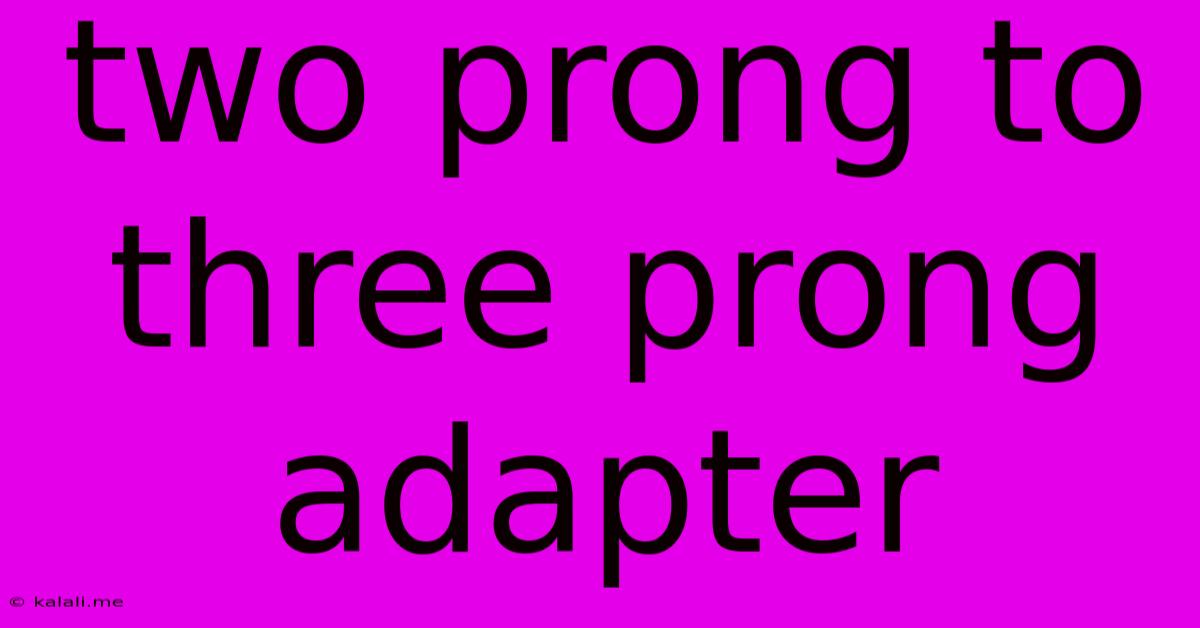Two Prong To Three Prong Adapter
Kalali
May 21, 2025 · 3 min read

Table of Contents
Two-Prong to Three-Prong Adapter: Safety, Functionality, and Choosing the Right One
Meta Description: Learn about the functionality and safety implications of using a two-prong to three-prong adapter. This guide helps you understand when it's safe and when to avoid using one, plus tips on choosing the right adapter for your needs.
Grounding is a crucial safety feature in electrical appliances. It protects against electric shock by providing a path for stray current to flow safely to the earth. Many older appliances and devices only have two-prong plugs, lacking this vital ground connection. This is where a two-prong to three-prong adapter comes in. But using one isn't always a straightforward solution. This article delves into the specifics of two-prong to three-prong adapters, exploring their function, safety considerations, and how to choose the appropriate adapter for your specific needs.
Understanding the Difference: Two-Prong vs. Three-Prong Plugs
A two-prong plug only features a hot and neutral wire, meaning it lacks the grounding wire present in a three-prong plug. Three-prong plugs incorporate a third grounding wire that connects the appliance's metal casing to the earth, diverting electrical current to prevent shocks. This grounding is particularly important for appliances with exposed metal parts.
When is a Two-Prong to Three-Prong Adapter Safe to Use?
The use of a two-prong to three-prong adapter is a complex issue and often depends on the specific appliance and its overall electrical design. Generally speaking, it is only safe to use an adapter when the appliance's casing is made of completely non-conductive material such as plastic. This prevents the possibility of electric shock should a fault occur within the appliance. If the casing is made of metal or other conductive material, using an adapter is extremely dangerous and should be avoided.
Consider these factors:
-
Appliance Type: Small appliances with plastic casings like lamps or clocks are often considered safer candidates. Avoid using adapters with appliances that have exposed metal parts or those that use significant amounts of power.
-
Adapter Quality: Ensure the adapter is properly made and is rated for the wattage of the device you plan to use it with. Cheap, poorly made adapters can pose a fire hazard.
-
Professional Assessment: If you're unsure, it's best to consult a qualified electrician. They can assess the appliance's safety features and determine if it's safe to use with an adapter.
When to Avoid Using a Two-Prong to Three-Prong Adapter
Using an adapter inappropriately can be extremely hazardous. It is crucial to never use a two-prong to three-prong adapter in the following scenarios:
-
Appliances with metal casings: These appliances require a ground connection for safety. Using an adapter without a proper ground wire creates a significant risk of electric shock.
-
High-wattage appliances: Adapters may not be able to handle the power draw of larger appliances, leading to overheating and potentially fire.
-
Damp or wet environments: Never use an adapter in areas where moisture is present, as this increases the risk of electric shock.
Choosing the Right Adapter
When selecting a two-prong to three-prong adapter, look for these key features:
- UL Listing: Ensure the adapter carries a UL (Underwriters Laboratories) listing, indicating that it has met safety standards.
- Wattage Rating: Check the wattage rating and ensure it exceeds the power consumption of the appliance you'll be using it with.
- Durable Construction: Opt for adapters made from durable, high-quality materials.
Safer Alternatives to Adapters
For appliances with metal casings or high wattage requirements, consider these alternatives:
- Replacing the appliance: The safest approach is to replace older two-prong appliances with newer models that have built-in three-prong plugs.
- Professional rewiring: A qualified electrician can rewire the appliance to incorporate a three-prong plug, though this is often more costly.
Ultimately, using a two-prong to three-prong adapter should be a carefully considered decision. Prioritizing safety should always be the top priority. When in doubt, always err on the side of caution and choose a safer alternative.
Latest Posts
Latest Posts
-
Can I Take Contact Lenses In Hand Luggage
May 21, 2025
-
Slinging This Spinner Over My Shoulder
May 21, 2025
-
Does Mdf Need To Be Primed
May 21, 2025
-
Screw In Tyre Can It Be Repaired
May 21, 2025
-
Does Wood Expand In The Heat
May 21, 2025
Related Post
Thank you for visiting our website which covers about Two Prong To Three Prong Adapter . We hope the information provided has been useful to you. Feel free to contact us if you have any questions or need further assistance. See you next time and don't miss to bookmark.